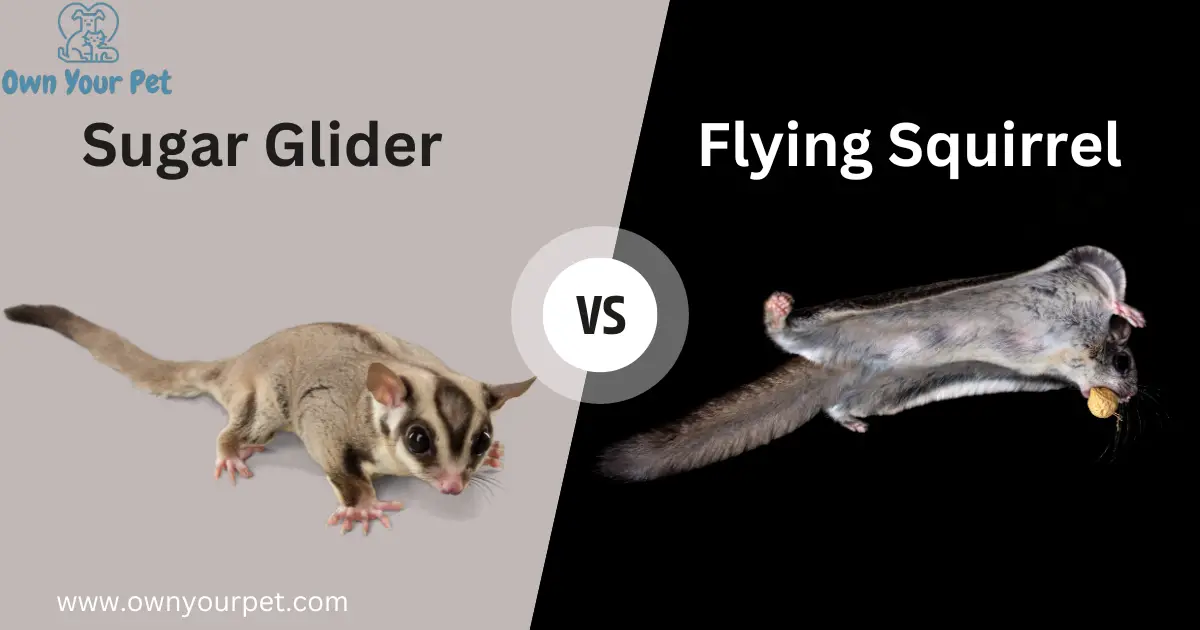Sugar Glider vs Flying Squirrel: Two extraordinary gliders take to the skies. In this article, we’ll delve into the fascinating world of these aerial acrobats, exploring their unique adaptations, behaviors, and the distinct characteristics that set them apart. Get ready for an exhilarating journey through the skies!
Sugar Glider vs Flying Squirrel: Everything You Need to Know
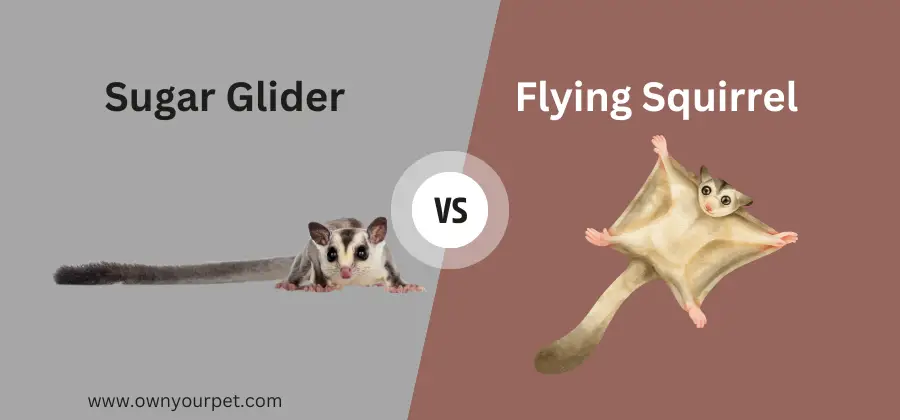
Many people are fascinated by the unique abilities of animals that can glide through the air, such as the sugar glider and the flying squirrel. Both of these creatures have gained attention for their incredible maneuverability, cute appearance, and similar features, such as the presence of a skin membrane called “patagium” that allows them to glide long distances.
However, despite their similarities, sugar gliders and flying squirrels have some distinct differences, which include their taxonomy, habitat, and physical features. Sugar gliders belong to the marsupial family, originating from Australia, while flying squirrels are rodents found in various parts of the world, including North America and Europe.
Though both species are nocturnal and have large eyes to help them forage for food during the night, sugar gliders tend to be smaller in size yet often weigh more than flying squirrels. They also live in eucalyptus trees, unlike flying squirrels that prefer deciduous forests as their habitat.
In this article, we will dive deeper into the key differences between these two enigmatic creatures, exploring their unique traits, behaviors, and preferred environments. By understanding the distinctions between sugar gliders and flying squirrels, you can appreciate the diverse capabilities and adaptations of these amazing gliding animals.
Physical Appearance: Sugar Glider vs Flying Squirrel
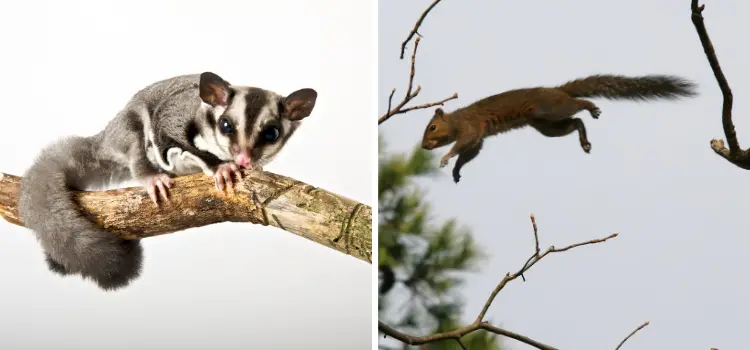
Size and Weight
Sugar gliders and flying squirrels are similar in appearance, but there are key differences in their size and weight. The average flying squirrel measures between 5-14 inches in length and weighs 2-5 ounces, while sugar gliders have a smaller frame, ranging from 4-7 inches in length and weighing 3-6 ounces on average.
Fur and Patagium
Both sugar gliders and flying squirrels have unique fur markings. Sugar gliders are known for their blue-grey fur and a dark stripe on their back. Flying squirrels, on the other hand, do not have stripes.
What sets these creatures apart from other mammals is their patagium – the membrane extending from their back legs to their front legs, allowing them to glide through the air. While both animals have a patagium, the shape and size may vary slightly between the two species.
Night Vision and Scent Glands
Sugar gliders and flying squirrels share some similarities in terms of their adaptation to nocturnal lifestyles. Both creatures have large eyes that help them see better at night, enabling them to navigate and search for food in the dark.
However, there are some differences in their scent glands. Sugar gliders have scent glands on their head, chest, and genital region, while flying squirrels have just a single pair located on their lower abdomen. These glands play a crucial role in communication and marking their territory.
Watch this Sugar Glider Facts: NOT a FLYING SQUIRREL video:
Habitat and Distribution: Sugar Glider vs Flying Squirrel
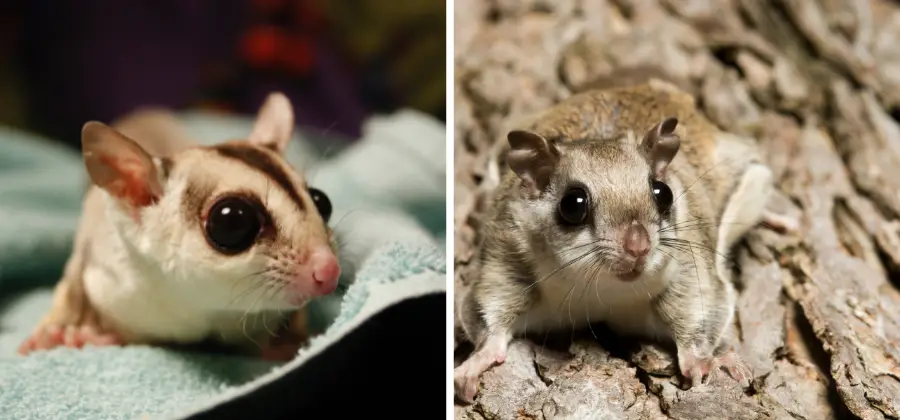
Geographical Range
Sugar gliders and flying squirrels have distinct geographical ranges that don’t overlap. Sugar gliders are native to New Guinea, Bismark Archipelago, and Northern and Eastern parts of Australia. Flying squirrels, on the other hand, live in North and Central America as well as parts of Eurasia, India, and Asia.
- Sugar Glider Distribution:
- Australia
- New Guinea
- Bismark Archipelago
- Flying Squirrel Distribution:
- North and Central America
- Northern Eurasia
- India
- Asia
Preferred Habitats
Both sugar gliders and flying squirrels prefer forested environments, but their specific habitat preferences differ. While sugar gliders are arboreal, which means they live in trees, they have an affinity for eucalyptus forests and primarily feed on the sugary sap, nectar, and other plant exudates.
Flying squirrels, however, can be found in various forest types, including coniferous, deciduous, and mixed forests. Within these habitats, they forage for nuts, seeds, and other food sources.
| Sugar Gliders | Flying Squirrels |
|---|---|
| Eucalyptus forests | Coniferous, deciduous, and mixed forests |
| Saps, nectar, and other plant exudates as diet | Nuts, seeds, and other food sources as diet |
In conclusion, sugar gliders and flying squirrels differ in both their habitat and distribution, as well as their adaptations to their respective environments. These differences are important for understanding the ecology and behavior of these unique gliding mammals.
Diet and Foraging Habits: Sugar Glider vs Flying Squirrel
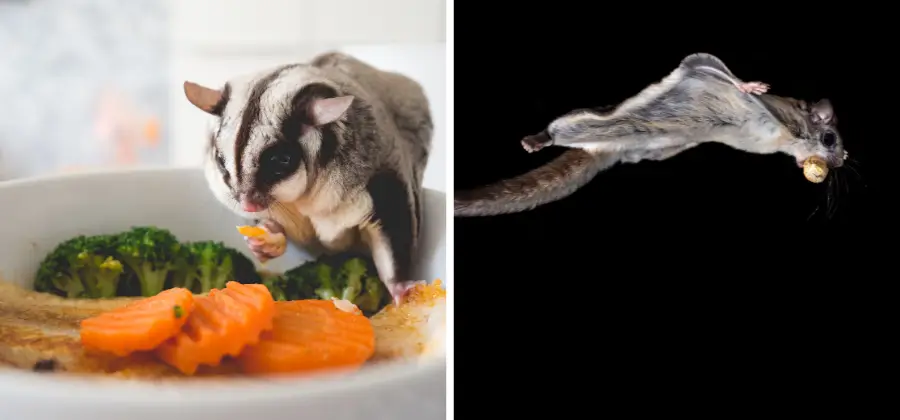
Omnivorous Diet
Sugar gliders and flying squirrels are both omnivorous animals with a varied diet consisting mainly of insects, seeds, nuts, and fungi. As marsupials, sugar gliders are native to Indonesia, Australia, and New Guinea, while flying squirrels can be found in various regions across the world.
Sugar Glider
Sugar gliders are known for their love of sweet foods, such as sugar and honey. In addition to their sweet preferences, they enjoy feasting on:
- Insects
- Fruits
- Nectar
- Sap
Flying squirrel
Flying squirrels, on the other hand, have a slightly different diet, consisting of:
- Nuts (especially acorns)
- Seeds
- Insects
- Fungi
- Occasionally bird eggs and nestlings
Notably, both sugar gliders and flying squirrels require a good balance of protein, carbohydrates, and fats within their diets to maintain proper health and energy levels.
Feeding Techniques
When it comes to foraging, sugar gliders and flying squirrels utilize various techniques to find and consume their favorite foods. Sugar gliders are adept at flying between trees using their gliding membranes, allowing them to access distant food sources with ease.
Along with their gliding skills, they have strong prehensile tails which they can use to hold onto branches while feeding.
Flying squirrels, too, glide between trees in search of food, covering distances of 50-65 feet. Unlike sugar gliders, flying squirrels have a more keen sense of smell. They can efficiently locate their preferred nuts, seeds, and fungi using their olfactory skills.
Once they find their food source, they are quick to consume the meal and move on to the next one.
Both sugar gliders and flying squirrels are primarily nocturnal creatures, with large eyes to help them navigate in low-light conditions. These animals tend to forage at night, relying on their remarkable senses and skills to locate and consume various food options available in their habitats.
Behavior and Lifestyle: Sugar Glider vs Flying Squirrel
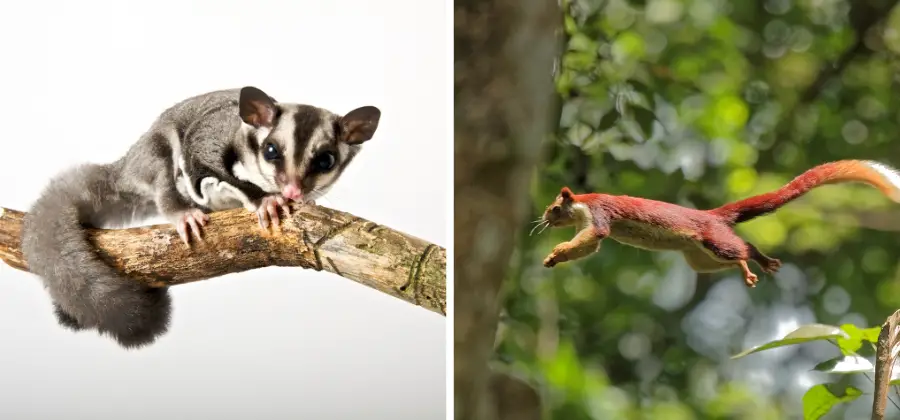
Nocturnal and Arboreal Nature
Both sugar gliders and flying squirrels are nocturnal animals, meaning that they are active during the night and sleep during the day. They are also arboreal, which means that they primarily live in trees.
Sugar gliders and flying squirrels have amazing adaptations that help them survive in their tree-filled habitats. Their large eyes help them to see better at night, while their bushy tails assist in their balance as they maneuver through the trees.
Gliding Abilities
One remarkable shared trait between sugar gliders and flying squirrels is their ability to glide. They have specialized skin membranes called gliding membranes, which extend from their wrists to their ankles.
- Sugar gliders, native to Indonesia, Australia, and New Guinea, use their gliding membrane to glide up to 150 feet. They can do so by adjusting the tension in the membrane, which allows them to control their direction and speed mid-flight.
- Flying squirrels, on the other hand, are found in North America and have a similar gliding membrane that enables them to soar even further, covering distances of over 150 feet.
These gliding abilities allow both the sugar glider and flying squirrel to avoid predators and move efficiently between trees in their natural habitat.
Social Structure
Sugar gliders and flying squirrels also have different social structures.
| Animal | Social Structure |
|---|---|
| Sugar Glider | Live in family groups called colonies, usually 5-7 individuals |
| Flying Squirrel | More solitary, adults normally live alone or in small family units |
Sugar gliders are more social and live in family groups, or colonies, that can number from 5 to 7 individuals. These tight-knit communities help establish a sense of safety and companionship among the sugar gliders.
In contrast, flying squirrels are more solitary creatures and prefer to live alone or in small family units. They do, however, interact with other flying squirrels during the breeding season.
Reproduction and Lifecycle: Sugar Glider vs Flying Squirrel
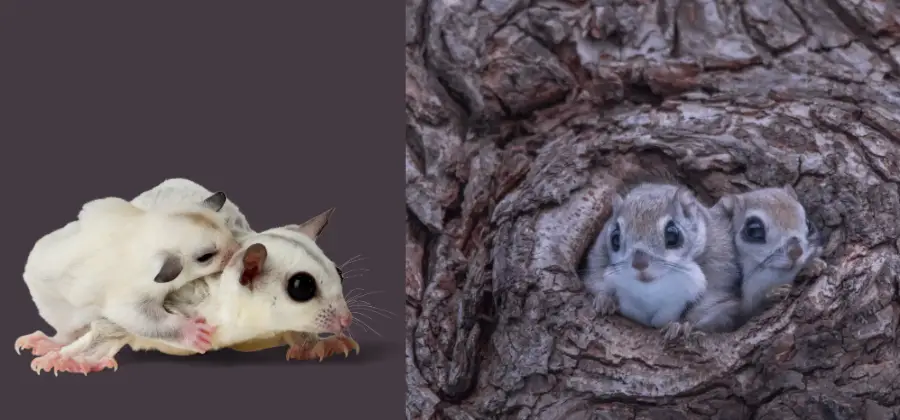
Mating and Gestation
Flying squirrels and sugar gliders have different reproductive strategies. Male flying squirrels mate with several different females during the mating season, and have a gestation period of forty days, producing one or two litters per year. The litter size can vary from one to six babies, with three or four being the average size.
Sugar gliders, on the other hand, are marsupials – a group of mammals that includes kangaroos and koala bears. Unlike placental mammals like flying squirrels, marsupials give birth to undeveloped young that continue to grow and develop outside the womb, usually in a pouch. The gestation period for sugar gliders is much shorter than that of flying squirrels, at just 15-17 days.
Joey Development
When it comes to their young, both species have some unique characteristics:
- Sugar Gliders: Marsupials like sugar gliders give birth to small, undeveloped joeys that then crawl into the mother’s pouch to continue their development. Inside the pouch, joeys latch onto a teat and receive nourishment while they grow. In the case of sugar gliders, their joeys spend approximately 70 days in the pouch before they venture out into the world.
- Flying Squirrels: As placental mammals, the babies of flying squirrels are born more fully developed than joeys of marsupials. They are born blind and hairless but quickly grow fur and open their eyes. Typical juvenile development includes learning to glide and forage for food. Flying squirrels reach maturity at around 10-12 months.
When it comes to lifespan, sugar gliders tend to live longer than flying squirrels. Southern flying squirrels have an average lifespan of 3-5 years in the wild and can live up to 10 years in captivity. Sugar gliders, in comparison, can live up to 12-14 years in captivity with proper care.
Exotic Pets and Legal Considerations: Sugar Glider vs Flying Squirrel
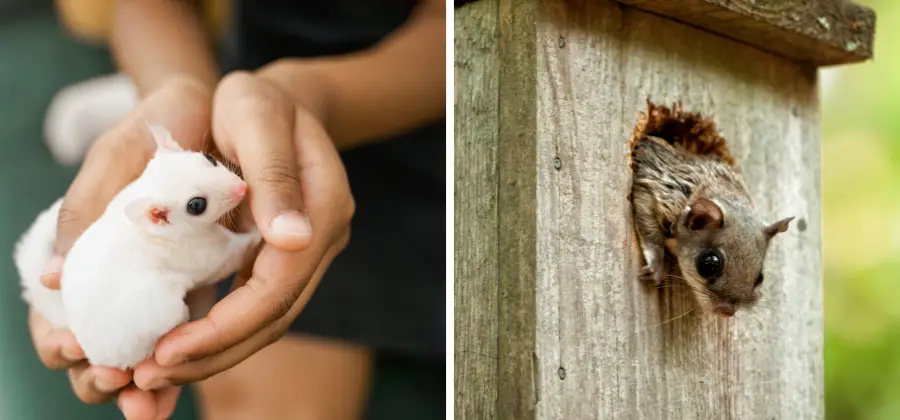
Care and Health Requirements
Sugar gliders and flying squirrels are both popular exotic pets known for their unique ability to glide through the air. However, these cute critters require specific care and health requirements to ensure they live a happy and healthy life.
Sugar Glider Care
- Sugar gliders are nocturnal marsupials native to Indonesia, Australia, and New Guinea. They need ample space for exercise and frequent handling to remain tame.
- Diet is crucial; they require a very particular diet, including fruits, vegetables, and protein sources.
- Providing toys and branches in their enclosure stimulates their curiosity and keeps them active.
Flying Squirrel Care
- Similar to sugar gliders, flying squirrels also need a spacious enclosure with branches and toys.
- A diet consisting of nuts, fruits, vegetables, and occasional insects keep flying squirrels healthy.
- Since they are largely nocturnal, flying squirrels require a quiet environment during the day to rest.
Ownership Laws
Legal considerations differ depending on where you live. Make sure to check local and regional ownership laws before committing to either of these exotic pets.
Sugar Glider Laws
- In some countries or states, sugar gliders may require a permit or may be illegal to own altogether.
- Breeding regulations may also apply, so it is essential to consult your local authorities to know the specific requirements.
Flying Squirrel Laws
- Flying squirrel ownership laws and restrictions can vary from one location to another.
- As native wildlife in some regions, they may be listed as protected species, and owning them as pets could be illegal or require a permit.
It is essential to research and understand the specific care and health requirements, along with legality, of owning sugar gliders or flying squirrels as exotic pets. Prioritizing their well-being will ensure a positive experience for both you and your charming little gliders.
Conservation Status and Threats: Sugar Glider vs Flying Squirrel

Sugar gliders and southern flying squirrels have similar conservation statuses. They are both considered to be in the least concern group of CITES species. This means that they are not currently facing any significant threats to their populations.
However, the northern flying squirrel faces a different situation. They were placed on the endangered list back in 1985. This reflects the increase in threats they face, such as habitat loss, climate change, and human activities.
Some factors that threaten both sugar gliders and flying squirrels include:
- Habitat loss: As forests are cleared for development or agriculture, the living spaces of these gliding animals become smaller and more fragmented. This can make it more challenging for them to find suitable nesting locations and access to food.
- Climate change: Global warming affects the habitats of flying squirrels and sugar gliders by altering the distribution of the plants and insects they rely on for food. Consequently, this may force them to adapt to new environments or face population decline.
- Human activities: Logging, road construction, and other human-led developments can destroy their natural habitats. In some cases, flying squirrels and sugar gliders may also face harm from collisions with vehicles or electrocution from power lines.
Efforts to protect and conserve flying squirrels and sugar gliders may include habitat restoration, the creation of wildlife corridors, or even legal protections that prevent further habitat destruction. By understanding the threats these fascinating creatures face, we can better work towards ensuring their survival in the wild.
Conclusion: Sugar Glider vs Flying Squirrel
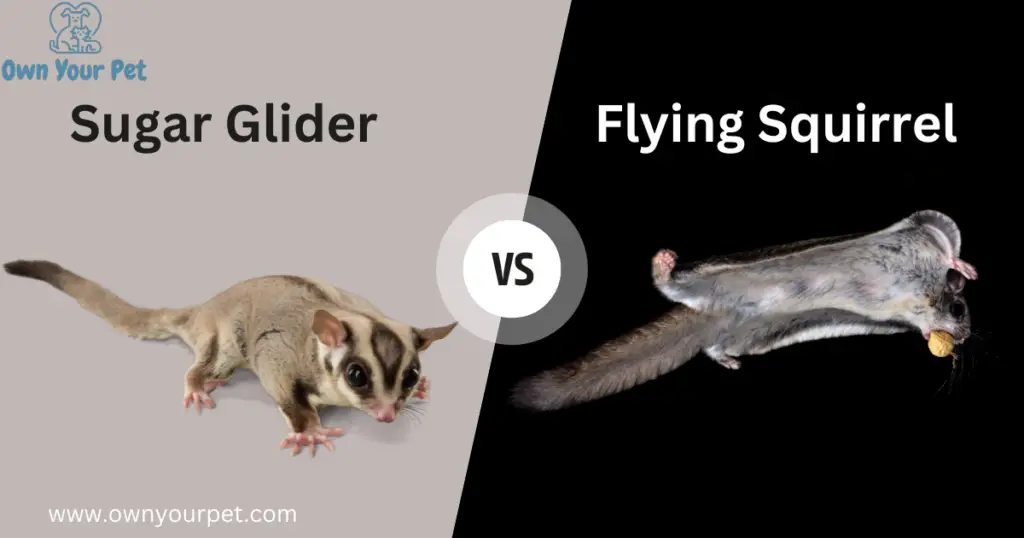
Sugar Gliders and Flying Squirrels, both marsupial mammals, may seem similar at first glance, but a closer look reveals intriguing differences between these social animals. In terms of habitat, Sugar Gliders are known for their remarkable tree-to-tree gliding abilities, while Flying Squirrels are escape artists skilled at navigating the tree canopy.
Geographical isolation has led to the evolution of distinct species of Sugar Gliders, each with its own unique physical traits. Female Sugar Gliders carry their young in a pouch-like uterus before birth, while female Flying Squirrels rely on tree hollows for nesting.
Their hunting styles also differ, with Sugar Gliders feasting on a variety of foods, including tree sap, while Flying Squirrels excel at catching insects mid-flight. As household pets, both species can form a strong connection with their human companions, but Sugar Gliders require more social interaction due to their natural selection as social creatures.
Whether you prefer pocket pets or household companions, the wide variety of communication in Sugar Gliders and the incredible physical differences between these remarkable gliders and squirrels offer endless fascination for nature lovers.
Frequently Asked Questions: Sugar Glider vs Flying Squirrel
How big are sugar gliders compared to flying squirrels?
Sugar gliders are smaller than flying squirrels. They typically measure 4-7 inches in length and weigh 3-6 ounces. Flying squirrels, on the other hand, are 5-14 inches long and weigh between 2-5 ounces.
What is the difference in their lifespan?
Sugar gliders generally live longer than flying squirrels. In the wild and captivity, sugar gliders can live up to 14 years. Flying squirrels have a lifespan of 3-5 years in the wild and 10-13 years in captivity.
How far can they glide?
Sugar gliders and flying squirrels can cover varying distances while gliding. Sugar gliders can glide around 150 feet in a single swoop, while flying squirrels can glide even further.
Are they nocturnal?
Yes, both sugar gliders and flying squirrels are nocturnal animals with large eyes that enable them to see better in low-light conditions.
What are their major differences?
While sugar gliders and flying squirrels may look similar, they have several key differences:
Size: Sugar gliders are smaller in size than flying squirrels.
Lifespan: Sugar gliders live longer than flying squirrels, with a lifespan of up to 14 years.
Gliding distance: Sugar gliders can glide up to 150 feet, while flying squirrels can cover a greater distance.
Origin: Sugar gliders are native to Australia, while flying squirrels are native to North America and Eurasia.
These differences set them apart and each has its own unique characteristics.
